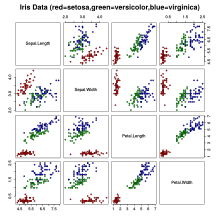
A data set (or dataset) is a collection of data. In the case of tabular data, a data set corresponds to one or more database tables, where every column of a table represents a particular variable, and each row corresponds to a given record of the data set in question. The data set lists values for each of the variables, such as for example height and weight of an object, for each member of the data set. Data sets can also consist of a collection of documents or files.
In the open data discipline, data set is the unit to measure the information released in a public open data repository. The European data.europa.eu portal aggregates more than a million data sets.
Properties
Several characteristics define a data set's structure and properties. These include the number and types of the attributes or variables, and various statistical measures applicable to them, such as standard deviation and kurtosis.
The values may be numbers, such as real numbers or integers, for example representing a person's height in centimeters, but may also be nominal data (i.e., not consisting of numerical values), for example representing a person's ethnicity. More generally, values may be of any of the kinds described as a level of measurement. For each variable, the values are normally all of the same kind. Missing values may exist, which must be indicated somehow.
In statistics, data sets usually come from actual observations obtained by sampling a statistical population, and each row corresponds to the observations on one element of that population. Data sets may further be generated by algorithms for the purpose of testing certain kinds of software. Some modern statistical analysis software such as SPSS still present their data in the classical data set fashion. If data is missing or suspicious an imputation method may be used to complete a data set.
Classics
Several classic data sets have been used extensively in the statistical literature:
- Iris flower data set – Multivariate data set introduced by Ronald Fisher (1936). Provided online by University of California-Irvine Machine Learning Repository.
- MNIST database – Images of handwritten digits commonly used to test classification, clustering, and image processing algorithms
- Categorical data analysis – Data sets used in the book, An Introduction to Categorical Data Analysis, provided online by UCLA Advanced Research Computing.
- Robust statistics – Data sets used in Robust Regression and Outlier Detection (Rousseeuw and Leroy, 1968). Provided online at the University of Cologne.
- Time series – Data used in Chatfield's book, The Analysis of Time Series, are provided on-line by StatLib.
- Extreme values – Data used in the book, An Introduction to the Statistical Modeling of Extreme Values are a snapshot of the data as it was provided on-line by Stuart Coles, the book's author.
- Bayesian Data Analysis – Data used in the book are provided on-line (archive link) by Andrew Gelman, one of the book's authors.
- The Bupa liver data – Used in several papers in the machine learning (data mining) literature.
- Anscombe's quartet – Small data set illustrating the importance of graphing the data to avoid statistical fallacies.
Example
Loading datasets using Python:
pip install datasets from datasets import load_dataset dataset = load_dataset(NAME OF DATASET)
See also
- List of datasets for machine-learning research
- List of datasets in computer vision and image processing
- Data blending
- Data (computer science)
- Sampling
- Data store
- Interoperability
- Data collection system
References
- ^ Fisher, R.A. (1963). "The Use of Multiple Measurements in Taxonomic Problems" (PDF). Annals of Eugenics. 7 (2): 179–188. doi:10.1111/j.1469-1809.1936.tb02137.x. hdl:2440/15227. Archived from the original (PDF) on 2011-09-28. Retrieved 2007-05-22.
- Snijders, C.; Matzat, U.; Reips, U.-D. (2012). "'Big Data': Big gaps of knowledge in the field of Internet". International Journal of Internet Science. 7: 1–5. Archived from the original on 2019-11-23. Retrieved 2017-02-10.
- "European open data portal". European open data portal. European Commission. Retrieved 2016-09-23.
- Jan M. Żytkow, Jan Rauch (2000). Principles of data mining and knowledge discovery. Springer. ISBN 978-3-540-66490-1.
- United Nations Statistical Commission; United Nations Economic Commission for Europe (2007). Statistical Data Editing: Impact on Data Quality: Volume 3 of Statistical Data Editing, Conference of European Statisticians Statistical standards and studies (PDF). United Nations Publications. p. 20. ISBN 978-9211169522.
- "UCI Machine Learning Repository: Iris Data Set". Archived from the original on 2023-04-26. Retrieved 2023-05-02.
- "Textbook Examples An Introduction to Categorical Data Analysis by Alan Agresti". Archived from the original on 2023-01-31. Retrieved 2023-05-02.
- "The ROUSSEEUW datasets". Archived from the original on 2005-02-07.
- "StatLib :: Data, Software and News from the Statistics Community". Archived from the original on 2011-01-02.
External links
- Data.gov – the U.S. Government's open data
- GCMD – the Global Change Master Directory containing over 34,000 descriptions of Earth science and environmental science data sets and services
- Humanitarian Data Exchange(HDX) – The Humanitarian Data Exchange (HDX) is an open humanitarian data sharing platform managed by the United Nations Office for the Coordination of Humanitarian Affairs.
- NYC Open Data – free public data published by New York City agencies and other partners.
- Relational data set repository Archived 2018-03-07 at the Wayback Machine
- Research Pipeline – a wiki/website with links to data sets on many different topics
- StatLib–JASA Data Archive
- UCI – a machine learning repository
- UK Government Public Data
- World Bank Open Data – Free and open access to global development data by World Bank